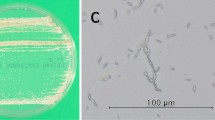Abstract
An unusual case ofRhizopus microsporus (mucormycosis) fungal infection in a teenage boy on continuous ambulatory peritoneal dialysis is presented. Premortem cultures were negative and the patient developed a rapidly disseminated fatal infection. The patient was being treated with deferoxamine (DFO) for iron and aluminum overload. An argument is made for a probable association between DFO and this fatal fungal infection in patients with end-stage renal disease.
Similar content being viewed by others
References
Fine RN, Salusky IB, Hall T, Lucillo L, Jordan S, Ettenger R, (1983) Peritonitis in children undergoing continuous ambulatory peritoneal dialysis. Pediatrics 71: 806–809
Mc Clung M (1983) Peritonitis in children receiving continuous ambulatory peritoneal dialysis. Pediatr Infect Dis J 2: 328–332
Hogg RJ, Arant BS, Hauser MT (1982) Candida peritonitis in children on continuous ambulatory peritoneal dialysis. Int J Pediatr Nephrol 3: 287–291
Kerr C, Perfect JR, Craven P, Jorgensen J, Drutz D, Shelburne S, Gallis H, Jutman R (1983) Fungal peritonitis in patients on CAPD. Ann Intern Med 99: 334–337
Oh SE, Conley SB, Rose GM, Rosenblum M, Kohl S, Pickering L (1985) Fungal peritonitis in children undergoing peritoneal dialysis. Pediatr Infect Dis J 4: 62–66
Eisenberg ES, Leviton I, Soeiro R (1986) Fungal peritonitis in patients receiving peritoneal dialysis: Experience with 11 patients and review of the literature. Rev Infect Dis 8: 309–321
Veis J, Contiguglio R, Klein M, Michell S, Olfrey A, Shapiro J (1986) Mucormycosis associated with desferoxamine use in hemodialysis patients. Am Soc Nephrol (Abstract)
Goodhill JJ, Abuelo JG (1987) Mucormycosis. A new risk of deferoxamine therapy in dialysis patients with aluminum or iron overload? N Engl J Med 317: 54
Windus DW, Stokes TJ, Julian BA, Fenves AL (1987) Fatalrhizopus infections in hemodialysis patients receiving deferoxamine. Ann Intern Med 107: 678–80
Hartman BJ (1986) Fungal pritonitis. Infect Surg: 27–36
Warady BA, Campoy SE, Gross SP, Sedman A, Lum G (1984) Peritonitis with continuous peritoneal dialysis and continuous cycling peritoneal dialysis. J Pediatr 105: 727–730
Southwest Pediatric Nephrology Study Group (1985) Continuous ambulatory and continuous cycling peritoneal dialysis in children. Kidney Int 27: 558–564
Straatsma BR, Zimmerman LE, Grass JDM (1962) Phycomycosis, a clinicopathologic study of fifty-one cases. Lab Invest 11: 963–985
Lehrer RI, Howard DH, Sypherd PS, Edwards S, Segal G, Winston D (1980) Mucormyucosis. Ann Intern Med 93: 93–108
Klein MW (1985) Mucormycosis in children: review of the literature and report of cases. Pediatr Infect Dis J 4: 672–676
Donris JE, Rhodes KH, Cooney DR, Roberts GD (1980) Nosocomial Rhizopus infection (zygomyucosis) in children. J Pediatr 96: 824–828
Meyer R, Rosen P, Armstrong D (1972) Phycomycosis complicating leukenia and lymphoma. Ann Intern Med 77: 871–879
Bodey GP (1986) Infection in cancer patients. Am J Med 81 (A): 11–25
Meyer RD, Armstrong D (1973) Mucormycosis: changing status. Crit Rev Clin Lab Sci 4: 421–451
Vas SI (1983) Microbiologic aspects of CAPD. Kidney Int 23
Diamond RD, Krzesicki R, Epstein B, Jao W (1978) Damage to hyphal forms of fungi by human leukocytes in vitro. Am J Pathol 91: 313–323
Bruun JN, Sooberg CO, Hambre E, Janssen C Jr, Arnold S, Eide J (1976) Acute disseminated phycomycosis in a patient with impaired neutrophil granulocyte function. Acta Pathol Microbiol Scand 84: 93–99
Kurz P, Kohler H, Meuer S, Hutteroth T, Meyer K (1986) Impaired cellular immune responses in chronic renal failure: evidence for a T cell defect. Kidney Int 29: 1209–1214
Charpentier B, Lang PH, Martin B, Noury J, Mathieu D, Fries D (1983) Depressed polymorphonuclear leukocyte function associated with normal cytotoxic functions of T and natural killer cells during chronic hemodialysis. Clin Nephrol 19: 288–294
Verbrugh HA, Keane WF, Hoidal JR (1983) Peritoneal macrophages and opsonins: antibacterial defense in patients undergoing chronic peritoneal dialysis. J Infect Dis 147: 1018–29
Barry DMJ, Reeve AW (1977) Increased incidence of gram negative neonatal sepsis with intramuscular iron administration. Pediatrics 60: 908–912
Melby K, Slurdahl S, Sutteberg TJ, Nordbo SA (1982) Septicaemia due toYersinia enterocolitica after oral overdose of iron. Br Med J 295: 467–468
Chiu HY, Flynn DM, Hoffbrand AV (1986) Infection withYersinia enterocolitica in patients with iron overload. Br Med J 292: 97
Robins-Browne RM, Prpic JK (1983) Desferrioxamine and systemic yersinosis. Lancet II: 1373
Andreoli SP, Dunn D, DeMyer W, Shenard D, Bergstein S (1985) Intraperitoneal desferoxamine therapy for aluminum intoxication in a child undergoing continuous ambulatory peritoneal dialysis. J Pediatr 107: 760–763
Falk RJ, Mattern WP, Lamanna RW, Littleman H, Parker N, Cross R, Rastall J (1983) Iron removal during continuous ambulatory peritoneal dialysis using desferoxamine. Kidney Int 24: 110–112
Carotenuto P, Pontesilli O, Cambier JC, Hayward AR (1986) Desferoxamine blocks IL-2 receptor expression on human T lymphocytes. J Immunol 136: 2342–2347
Lederman HM, Cohen A, Lee JWW, Freedman M, Gelband E (1984) Desferoxamine: a reversible S-phase inhibitor of human lymphocyte proliferation. Blood 64: 748–753
Bullen JJ (1981) The significance of iron in infection. Rev Infect Dis 3: 1127–1138
Bowern N, Ranshaw IA, Badench-Jones P, Doherty PC (1984) Effect of an iron chelating agent on lymphocyte proliferation. Aus J Exp Biol Med Sci 62: 743–754
Author information
Authors and Affiliations
Rights and permissions
About this article
Cite this article
Nakamura, M., Weil, W.B. & Kaufman, D.B. Fatal fungal peritonitis in an adolescent on continuous ambulatory peritoneal dialysis: association with deferoxamine. Pediatr Nephrol 3, 80–82 (1989). https://doi.org/10.1007/BF00859631
Received:
Revised:
Accepted:
Issue Date:
DOI: https://doi.org/10.1007/BF00859631




